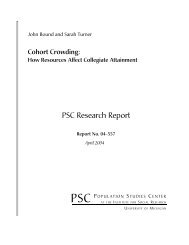Population Ageing and the Well-Being of Older Persons in Thailand ...
Population Ageing and the Well-Being of Older Persons in Thailand ...
Population Ageing and the Well-Being of Older Persons in Thailand ...
Create successful ePaper yourself
Turn your PDF publications into a flip-book with our unique Google optimized e-Paper software.
12<br />
In this report we consider both those who cannot<br />
perform <strong>the</strong> activity or can only perform <strong>the</strong><br />
activity with assistance or an aid as hav<strong>in</strong>g a<br />
functional limitation with respect to <strong>the</strong> activity.<br />
13<br />
Among all respondents age 60 <strong>and</strong> over, only one<br />
per cent were coded as need<strong>in</strong>g assistance but not<br />
receiv<strong>in</strong>g it while 88 per cent were coded as do<strong>in</strong>g<br />
<strong>the</strong>se activities by <strong>the</strong>mselves with no qualification.<br />
14<br />
Because <strong>of</strong> data problems, estimates <strong>of</strong> liv<strong>in</strong>g<br />
arrangements at <strong>the</strong> time <strong>of</strong> <strong>the</strong> 2002 Survey <strong>of</strong><br />
<strong>Older</strong> <strong>Persons</strong> <strong>in</strong> Thail<strong>and</strong> are estimated<br />
primarily from <strong>the</strong> concurrent round <strong>of</strong> <strong>the</strong> Labour<br />
Force Survey (see Knodel et al. 2005).<br />
15<br />
In <strong>the</strong> vast majority <strong>of</strong> cases, coresidence <strong>in</strong>volves<br />
at least one adult child, For example, <strong>in</strong> 2007,<br />
less that two per cent <strong>of</strong> coresident elderly lived<br />
with children who all were under age 18.<br />
16<br />
S<strong>in</strong>ce a child <strong>in</strong>-law can serve many <strong>of</strong> <strong>the</strong> same<br />
functions as an elderly person’s own married child<br />
<strong>and</strong> <strong>in</strong> this table we <strong>in</strong>clude <strong>the</strong> one per cent <strong>of</strong><br />
cases <strong>in</strong> which an older person lives with a child<br />
<strong>in</strong>-law but not with a married child <strong>in</strong> <strong>the</strong> same<br />
category as liv<strong>in</strong>g with a married child.<br />
17<br />
In some <strong>of</strong> <strong>the</strong>se households <strong>the</strong>re will be s<strong>in</strong>gle<br />
children <strong>of</strong> <strong>the</strong> gr<strong>and</strong>parent but it is highly un<br />
likely that any would be <strong>the</strong> parents <strong>the</strong><br />
gr<strong>and</strong>children. At <strong>the</strong> same time, situations <strong>in</strong><br />
which a married child is present but gr<strong>and</strong>children<br />
from a non co-resident child are also present will<br />
not be <strong>in</strong>cluded.<br />
18<br />
The purpose <strong>of</strong> <strong>the</strong> latter measure is to determ<strong>in</strong>e<br />
if <strong>the</strong> gender <strong>of</strong> <strong>the</strong> gr<strong>and</strong>parent affects <strong>the</strong><br />
presence <strong>of</strong> gr<strong>and</strong>children without parents. This<br />
is not possible to determ<strong>in</strong>e if both gr<strong>and</strong>parents<br />
are present but should be apparent from<br />
comparisons <strong>of</strong> situations where only one is<br />
present.<br />
19<br />
The lack <strong>of</strong> change <strong>in</strong> dependence on children as<br />
a ma<strong>in</strong> source <strong>of</strong> <strong>in</strong>come is confirmed by both <strong>the</strong><br />
1986 Socio-Economic Consequences <strong>of</strong> <strong>the</strong><br />
Ag<strong>in</strong>g <strong>of</strong> <strong>the</strong> <strong>Population</strong> <strong>in</strong> Thail<strong>and</strong> survey <strong>and</strong><br />
<strong>the</strong> 1995 Survey <strong>of</strong> Welfare <strong>of</strong> Elderly <strong>in</strong><br />
Thail<strong>and</strong> which f<strong>in</strong>d similar proportions <strong>of</strong> older<br />
persons say<strong>in</strong>g that children are <strong>the</strong>ir ma<strong>in</strong> source<br />
<strong>of</strong> <strong>in</strong>come (Knodel et al. 2000)<br />
20<br />
For example, among elderly parents with at least<br />
one non co-resident child, 65 per cent who live<br />
<strong>in</strong> skip generation households receive remittances<br />
<strong>of</strong> 5000 baht or more compared to only 48 per<br />
cent who are not <strong>in</strong> a skip generation household.<br />
21<br />
The survey question does not specify which<br />
children provide money. Thus for parents who live<br />
with co-resident children <strong>the</strong> money may be<br />
provided by a non co-resident child; for categories<br />
<strong>of</strong> non co-resident children, <strong>the</strong> nearest one is not<br />
necessarily <strong>the</strong> one provid<strong>in</strong>g <strong>the</strong> money.<br />
22<br />
The survey question asks collectively about visits<br />
from non co-resident children. Presumably for<br />
parents with multiple non co-resident children,<br />
responses refer to highest frequency <strong>of</strong> any <strong>of</strong> <strong>the</strong><br />
children although possibly some respondents state<br />
an average frequency for all non co-resident<br />
children.<br />
23<br />
E-mail contact, which is extremely rare, <strong>and</strong><br />
letters for which <strong>the</strong>re is no <strong>in</strong>formation are not<br />
taken <strong>in</strong>to account.<br />
24<br />
Only modest differences are evident between<br />
urban <strong>and</strong> rural residents. Overall 75 per cent <strong>of</strong><br />
urban adults compared to 82 per cent <strong>of</strong> rural<br />
adults expect f<strong>in</strong>ancial support from children <strong>in</strong><br />
old age but even this difference is <strong>in</strong> part<br />
attributable to <strong>the</strong> higher proportion <strong>of</strong> urban<br />
residents are s<strong>in</strong>gle. Among ever married adults,<br />
82 per cent <strong>of</strong> urban residents <strong>and</strong> 87 per cent <strong>of</strong><br />
rural residents expect support.<br />
71















